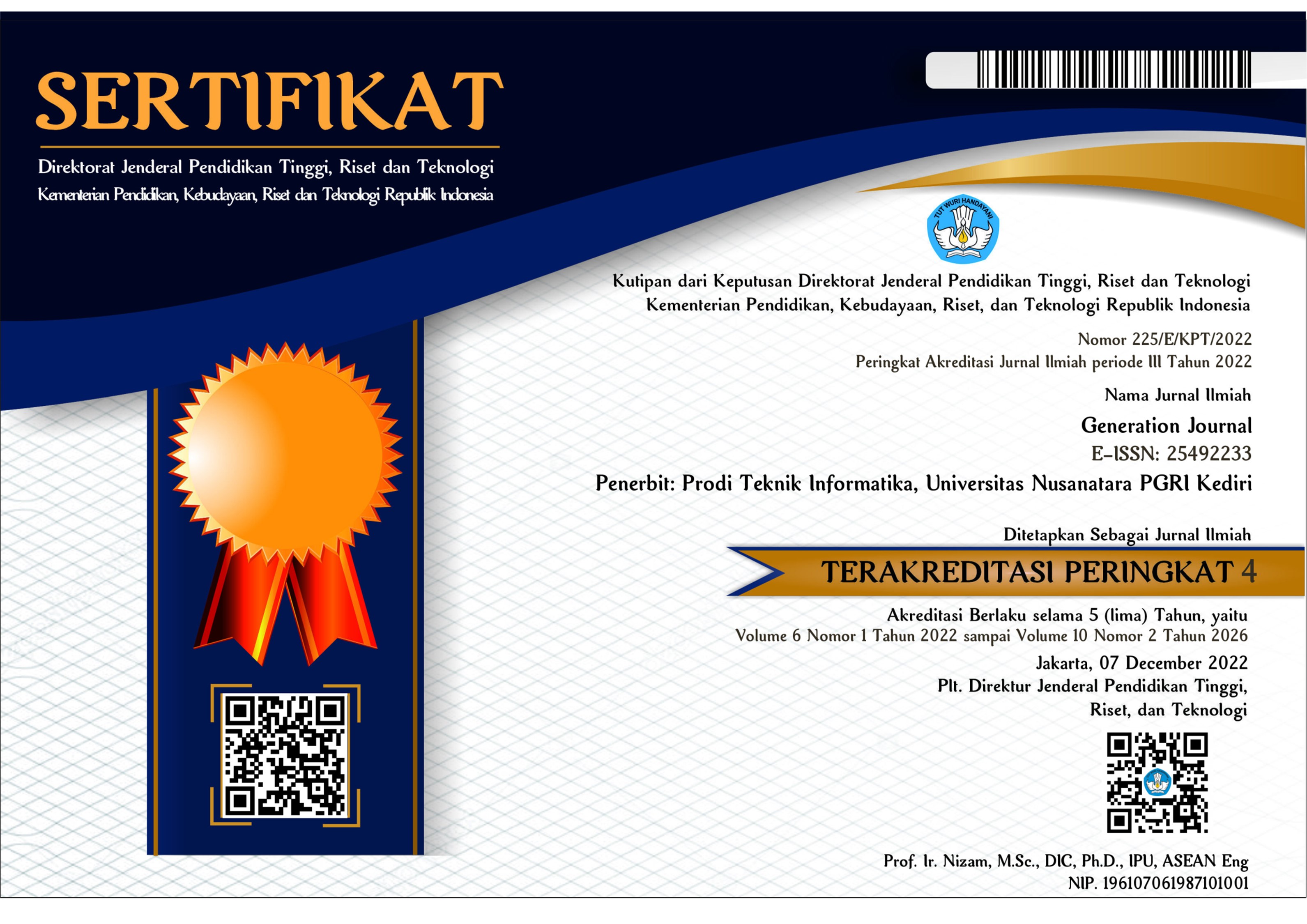Forecasting Pergerakan Harga Volatility Index dengan Menggunakan Metode Fuzzy Tsukamoto dan Evaluasi Dstat Metric
DOI:
https://doi.org/10.29407/gj.v7i1.19605Keywords:
Fuzzy Tsukamoto, Fuzzy Logic, Forecasting, Dstat MetrixAbstract
Volatility index is one of the assets traded in trading activities. In this activity there are two possibilities that can be done by traders, namely buy and sell actions. This is the main problem in forecasting in the world of finance. With these two opportunities, an analysis is needed to estimate the direction of price movement correctly. In addition in trading the subjectivity factor sees very high price movements. In a sense, each individual trader has his own assumptions. So a non-subjective analysis system is needed. Based on these challenges, this research will focus on forecasting with a non-subjective approach with fuzzy logic or more precisely Fuzzy Tsukamoto and Dstat metric as an evaluation of the level of correctness of the prediction direction. From the results that have been tested in the study, the Fuzzy Tsukamoto Method by reading the Relative Strength Index and Stochastic Oscillators indicators received an evaluation value that met the trading industry standards of 64.13%.
References
Y. H. Lui and D. Mole, “The use of fundamental and technical analyses by foreign exchange dealers: Hong Kong evidence,” J. Int. Money Financ., vol. 17, no. 3, pp. 535–545, 1998, doi: 10.1016/S0261-5606(98)00011-4.
D. C. Yıldırım, I. H. Toroslu, and U. Fiore, “Forecasting directional movement of Forex data using LSTM with technical and macroeconomic indicators,” Financ. Innov., vol. 7, no. 1, pp. 1–36, 2021, doi: 10.1186/s40854-020-00220-2.
D. A. Pelta, M. T. Lamata, J. L. Verdegay, C. Cruz, and A. Salas, “Against Artificial Complexification: Crisp vs. Fuzzy Information in the TOPSIS Method,” Jt. Proc. 19th World Congr. Int. Fuzzy Syst. Assoc. (IFSA), 12th Conf. Eur. Soc. Fuzzy Log. Technol. (EUSFLAT), 11th Int. Summer Sch. Aggreg. Oper. (AG, vol. 3, pp. 345–351, 2021, doi: 10.2991/asum.k.210827.046.
A. Adegboye and M. Kampouridis, “Machine learning classification and regression models for predicting directional changes trend reversal in FX markets,” Expert Syst. Appl., vol. 173, no. August 2020, p. 114645, 2021, doi: 10.1016/j.eswa.2021.114645.
M. Yasir et al., “An intelligent event-sentiment-based daily foreign exchange rate forecasting system,” Appl. Sci., vol. 9, no. 15, 2019, doi: 10.3390/app9152980.
A. Hernandez-Aguila, M. Garcia-Valdez, J. J. Merelo-Guervos, M. Castanon-Puga, and O. C. Lopez, “Using Fuzzy Inference Systems for the Creation of Forex Market Predictive Models,” IEEE Access, vol. 9, pp. 69391–69404, 2021, doi: 10.1109/ACCESS.2021.3077910.
P. C. de Lima e Silva, C. A. Severiano, M. A. Alves, R. Silva, M. Weiss Cohen, and F. G. Guimarães, “Forecasting in non-stationary environments with fuzzy time series,” Appl. Soft Comput. J., vol. 97, p. 106825, 2020, doi: 10.1016/j.asoc.2020.106825.
W. Gan, Z. Du, W. Ding, C. Zhang, and H. C. Chao, “Explainable Fuzzy Utility Mining on Sequences,” IEEE Trans. Fuzzy Syst., vol. 29, no. 12, pp. 3620–3634, 2021, doi: 10.1109/TFUZZ.2021.3089284.
L. T. H. Lan et al., “A new complex fuzzy inference system with fuzzy knowledge graph and extensions in decision making,” IEEE Access, vol. 8, pp. 164899–164921, 2020, doi: 10.1109/ACCESS.2020.3021097.
D. M. Durairaj and B. H. K. Mohan, “A convolutional neural network based approach to financial time series prediction,” Neural Comput. Appl., vol. 34, no. 16, pp. 13319–13337, 2022, doi: 10.1007/s00521-022-07143-2.
G. Cortazar, M. Enberg, and H. Ortega, “Forecasting Copper Prices When to Use Either Futures Prices, Analysts’ Expectations, or Both,” SSRN Electron. J., 2021, doi: 10.2139/ssrn.3957305.
X. Zhang, J. Wang, and Y. Gao, “A hybrid short-term electricity price forecasting framework: Cuckoo search-based feature selection with singular spectrum analysis and SVM,” Energy Econ., vol. 81, pp. 899–913, 2019, doi: 10.1016/j.eneco.2019.05.026.
I. T. Imano and B. Nugroho Eko, “SISTEM TRADING FOREX OTOMATIS MENGGUNAKAN INDIKATOR RSI DAN MA DENGAN METODE MARTINGALE DI METATRADER 4,” vol. 1, no. 1, pp. 10–14, 2019.
A. Noertjahyana, Z. A. Abas, and Z. I. M. Yusoh, “Combination of Candlestick Pattern and Stochastic to Detect Trend Reversal in Forex Market,” TIMES-iCON 2019 - 2019 4th Technol. Innov. Manag. Eng. Sci. Int. Conf., pp. 1–4, 2019, doi: 10.1109/TIMES-iCON47539.2019.9024485.
M. Tlustý, “Technical Analysis of Selected Stocks Time Series Based on Value Screening,” SHS Web Conf., vol. 135, p. 01016, 2022, doi: 10.1051/shsconf/202213501016.
A. K. Panigrahi, K. Vachhani, and S. K. Chaudhury, “Trend identification with the relative strength index (RSI) technical indicator –A conceptual study,” J. Manag. Res. Anal., vol. 8, no. 4, pp. 159–169, 2021, doi: 10.18231/j.jmra.2021.033.
F. S. D. Arianto and N. P, “Prediksi Kasus Covid-19 Di Indonesia Menggunakan Metode Backpropagation Dan Fuzzy Tsukamoto,” J. Teknol. Inf., vol. 4, no. 1, pp. 120–127, 2020, doi: 10.36294/jurti.v4i1.1265.
N. I. Kurniati, R. R. El Akbar, and P. Wijaksono, “Penerapan Metode Fuzzy Tsukamoto Pada Sistem Pakar untuk Mendiagnosa Autisme Pada Anak,” Innov. Res. Informatics, vol. 1, no. 1, pp. 21–27, 2019, doi: 10.37058/innovatics.v1i1.676.
H. N. Hadi and W. F. Mahmudy, “Penilaian Prestasi Kinerja Pegawai Menggunakan Fuzzy Tsukamoto,” J. Teknol. Inf. dan Ilmu Komput., vol. 2, no. 1, p. 41, 2015, doi: 10.25126/jtiik.201521129.
Downloads
Published
Issue
Section
License
Authors who publish with this journal agree to the following terms:
- Copyright on any article is retained by the author(s).
- The author grants the journal, the right of first publication with the work simultaneously licensed under a Creative Commons Attribution License that allows others to share the work with an acknowledgment of the work’s authorship and initial publication in this journal.
- Authors are able to enter into separate, additional contractual arrangements for the non-exclusive distribution of the journal’s published version of the work (e.g., post it to an institutional repository or publish it in a book), with an acknowledgment of its initial publication in this journal.
- Authors are permitted and encouraged to post their work online (e.g., in institutional repositories or on their website) prior to and during the submission process, as it can lead to productive exchanges, as well as earlier and greater citation of published work.
- The article and any associated published material is distributed under the Creative Commons Attribution-ShareAlike 4.0 International License














